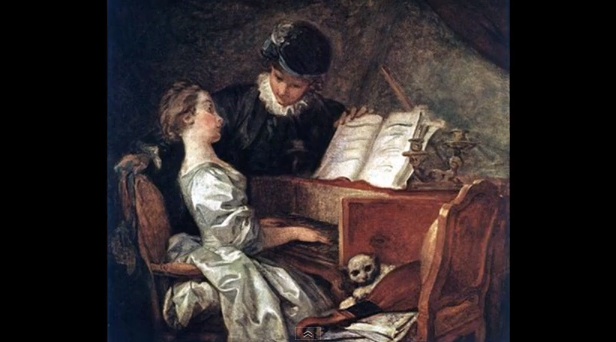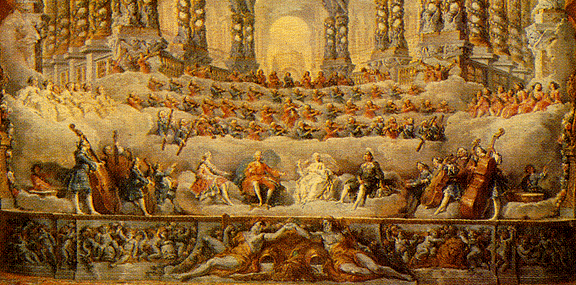The Baroque era in music generally spans 1600 to 1750. Mistress of the Sun and The Shadow Queen fall in what is called the “High Baroque” period (1650-1700), when French music rose to one of the peaks of its own unique expressive style.
Today, the best-known French Baroque composers are Jean-Baptiste Lully (1632-1687), Marc-Antoine Charpentier (1643-1704) and Jean-Phillippe Rameau (1683-1764).
Jean-Baptiste Lully
Lully, a dancer and violinist born in Italy, became the court composer to Louis XIV in 1661, and a personal friend of the King. For over twenty years, he created the soundtrack underpinning all great occasions during the Sun King’s reign, including church music, operas, ballets, and much, much more.
YouTube has free excerpts of French Baroque music performed by ‘period’ ensembles, or groups that play using instruments and styles similar to those used at the time.
This excerpt of Lully’s brilliant opera Armide (1686), performed by Les Arts Florissants, directed by William Christie, gives an idea of the beautiful sounds of this period. This excellent group regularly plays and records French Baroque music. Also look out for Le Concert d’Astrée, directed by Emmanuelle Haim, and the work of Le Concert des Nations, directed by Jordi Savall, amongst many others.
Marc-Antoine Charpentier
Charpentier’s life was not so charmed. Labouring in Lully’s shadow, but arguably of equal talent, Charpentier never succeeded at getting an all-important court appointment but depended largely on the support of the powerful Jesuits. Even after Lully’s death in 1687, groups of Lully’s fans decried Charpentier’s work, insisting it was ‘too Italian’ to be truly French music. This hindered his success in his own lifetime, but his music is extraordinarily beautiful: you can listen to a live performance of a sonata for eight instruments here, played by the orchestra of Les Folies Françoises. Charpentier’s operas, like Médée, and oratorios, like David et Jonathas, are well worth seeking out on CD, but they’re best of all in live performance!

Jean-Phillippe Rameau
Where Lully was France’s greatest composer of the seventeenth century, Rameau was the giant of the eighteenth: he began his career as a celebrated music theorist and teacher and a composer of keyboard pieces, like the Pièces de clavecins (here played by Blandine Rannou).
Rameau only started writing opera at the age of 50, but they astonished the Parisian community, and immediately caused great conflict with the conservative fans of the sounds of Lully. He still met with great success, and collaborated with many fine authors, including Voltaire, to produce brilliant opera. ‘Tristes apprêts, pâles flambeaux’ is just one song from his opera Castor et Pollux; the video contains French and English subtitles, as well as glimpses of the musical manuscript and stills from the 2006 film “Marie Antoinette.”

You might also enjoy …
Although not necessarily a perfect historical or geographical fit, I enjoy the following YouTube links for background listening. (You might notice that they have a somewhat different sound from the examples above. Most of these are played on what we think of as modern instruments, whereas the examples above are played on “period” instruments, and are, therefore, closer to the original sound.)
The Best of Baroque: with renowned harpsichordist Ed Clark, violinist Brunilda Myftaraj and cellist Kathy Schiano.
Baroque Garden for Concentration — No. 7
Airs de Cour — French Court Music from the 17th Century.
From the “High Baroque” period in Venice:
Vivaldi’s Flute Concerto in D Major, RV429, played by the Accademia Montis Regalis.
Vivaldi’s Flute Concerto in G minor, ‘La Notte’, Op.10/2, played by Europa Galante.
‘Winter’ from Vivaldi’s Four Seasons, played by the excellent Il Giardino Armonico.
Educational overviews:
For an educational overview, I recommend Best Baroque Music Composers, French Baroque (a lecture on “High Baroque” style plus recordings) and My favourite Baroque music.
A CD recommendation:

A beautiful CD, should you wish to purchase, is Chorégraphie, Music for Louis XIV’s dancing masters, by Andrew Lawrence-King.
Enjoy!
Most all of the knowledgeable information on this page is from Dr. Katie De La Matter, a scholar and performer of Baroque music. Thank you, Dr. Katie!
Information about the glorious image at the top can be found here.


